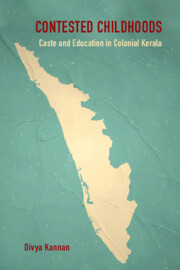4 - Cultivating Virtue
Published online by Cambridge University Press: aN Invalid Date NaN
Summary
In recent decades, South Asian book history has stimulated new conversations to understand the impact of seemingly mundane print artefacts such as schoolbooks in shaping linguistic and script cultures. Many scholars studying education, childhood, print histories, and state formation, among other areas of interest, have begun scrutinizing schoolbooks to understand socially embedded norms and entangled knowledge networks in colonial India. Their circulation and reception across various age groups in the past may be difficult to discern, but they continue to be one of the few printed mass artefacts consumed together by school-going children globally at a given point in time. As a result, we can gain a deeper understanding of pedagogy as an outcome of broad social and political discourse across multiple spatial and temporal scales.
In 1800, the Baptist missionary trio William Carey, Joshua Marshman, and William Ward established the first printing press in the subcontinent in the Danish-controlled territory of Srirampur (Serampore), near Calcutta, and undertook several translations of European texts into local languages and printing of schoolbooks, which soon gained great popularity in the Bengal Presidency. For evangelical purposes, these Protestant missionaries printed numerous tracts, pamphlets, newspapers, and treatises which were usually sold with the help of colporteurs and book sale depots. But it was the popularization of schoolbook writing as a separate genre that witnessed significant missionary influence on a new culture of literacy and educational practices in the colony. In subsequent years, many Protestant missionaries and upper-caste social reformers compiled grammars, primers, readers, and dictionaries that aided the process of script standardization and regional literature alongside a thriving print culture by the late nineteenth century. The circulation of printed texts for child readers was closely interconnected with the spread of public instruction in the mofussil towns and villages, established through the network of government, aided, and unaided vernacular and English-medium schools. With organizations such as the Calcutta, Madras, and Bombay schoolbook societies drawing up lists of textbooks suitable for instruction and with the recruitment of popular writers and administrators as authors, schoolbooks, especially language readers, began to enjoy a slow and steady demand from the late 1820s onwards.
- Type
- Chapter
- Information
- Contested ChildhoodsCaste and Education in Colonial Kerala, pp. 173 - 218Publisher: Cambridge University PressPrint publication year: 2024

